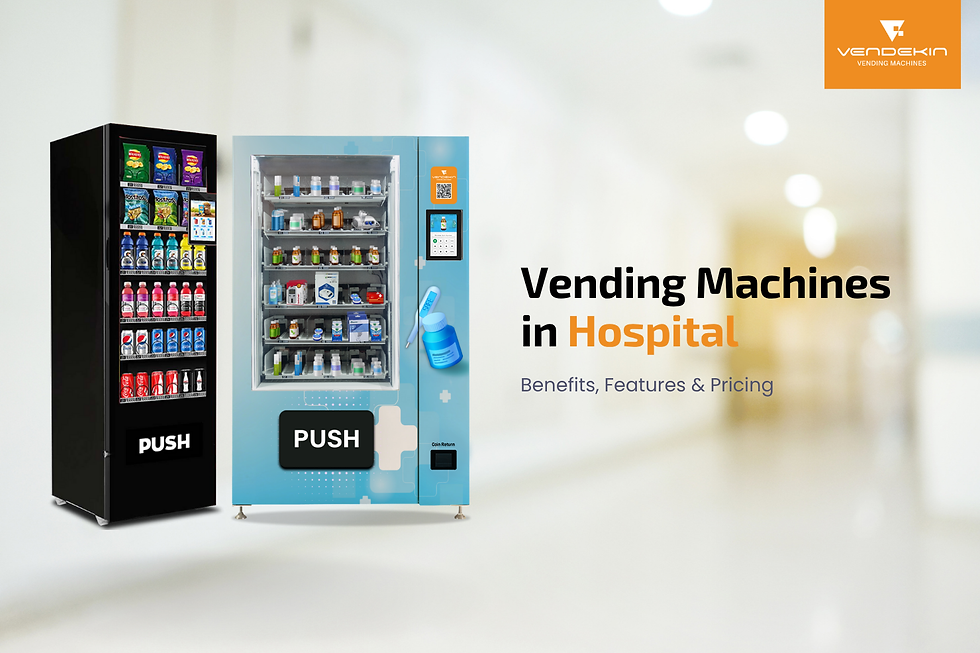How to Choose the Right Vending Machine for Your Hospital
- Abhishek Sharma

- Jul 25
- 3 min read

Hospitals operate 24×7 and serve a diverse audience—patients, visitors, and staff—each with unique refreshment and healthcare needs. A well-selected hospital vending machine can improve patient satisfaction, streamline staff workflows, and even generate ancillary revenue. In this commercial guide, we’ll walk you through the key factors procurement managers must consider when selecting snack & beverage kiosks, OTC medicine dispensers, or hybrid solutions tailored for the healthcare environment.
1. Define Your Use Cases
Staff & Visitor Refreshment
Snacks & Beverages: Coffee, tea sachets, cold drinks, healthy bars for break rooms and waiting areas.
24×7 Access: Accommodate night-shift nurses and late-visiting families.
On-Demand OTC Medicines & First-Aid
Medical Essentials: Analgesics, antacids, bandages, and sanitizers near nurse stations or emergency wings.
Prescription Validation: For prescription items, integrated e-prescription or QR-code scanning modules.
Hybrid Kiosks
Combine snacks, chilled beverages, and healthcare products in a single footprint to maximize convenience.
2. Key Selection Criteria
Criterion | Considerations |
Hygiene & Safety | Sealed packaging, antimicrobial surfaces, UV-sterilized dispensing areas |
Temperature Control | Dual-zone cooling (4 °C–25 °C) for drinks/snacks and a separate 4 °C–25 °C zone for heat-sensitive meds |
Payment & Invoicing | UPI (PhonePe, GPay), RFID card acceptance + integration with hospital ERP or invoicing software for cost-center billing |
Remote Monitoring | Real-time telemetry on sales, stock levels, temperature alarms, and error alerts via a cloud dashboard (vNetra) |
Accessibility (ADA) | ADA-compliant placement and machine height; tactile buttons or voice-assistance options for visually impaired |
Footprint & Placement | Compact models for corridors vs. high-capacity units for cafeterias; low noise for patient areas |
Regulatory Compliance | FSSAI for food/drink; CDSCO or state health approvals for OTC dispensing; regular audit logs |
Service & Maintenance | Local partner network for restocking, filter changes (if any), and rapid technical support |
3. Recommended Vendekin Models
3.1 Omnivend Combo 10 Snack & Beverage
Use Case: Staff lounges, waiting rooms
Specs: 10″ touchscreen • 250–500 SKUs • 700 W cooling • 4 °C–25 °C • multi-vend up to 5 items
Features: Cashless payments, remote stock alerts, 90° door for easy restocking
Starting Price: ₹1,65,000*
3.2 Omnivend Combo 22 Hybrid
Use Case: Main cafeteria or lobby where both refreshments and medical essentials are needed
Specs: 22″ touchscreen • 500 SKUs • 1500 W dual-zone cooling • –18 °C to 25 °C configurable sections
Features: Elevator lift system for delicate items, full telemetry, custom branding panels
Starting Price: ₹1,85,000*
*Prices are indicative and may go up or down at time of purchase based on configuration and volume discounts.
4. Placement & Installation Tips
Corridor vs. Lounge:
Narrow corridors: Choose compact, under-counter units or wall-mounted dispensers.
Staff lounges & cafeterias: High-capacity floor models with premium touchscreen displays.
Nurse-Station Integration:
Position pharmacy machines within line of sight of nurses for quick OTC access.
Ensure power outlets and network ports are discreetly routed to avoid trip hazards.
Accessibility & Wayfinding:
Clearly signpost machines and include floor decals for patients with mobility challenges.
Place at a height compliant with ADA guidelines (max 120 cm dispensing level).
Read More: https://www.vendekin.com/post/where-place-vending-machine-best-locations-vending-machines
5. Drive Adoption & ROI
Staff Awareness Campaigns: Email blasts and digital signage to inform employees of 24×7 access and cashless ease.
Promotional Bundles: Combine a snack + drink or OTC kit at a slight discount to encourage trial.
Analytics-Driven Optimization: Use telemetry data to refine product mix—swap out slow-moving SKUs for high-margin items.
Cost Center Billing: Leverage invoicing integration so departmental budgets can be charged automatically.
Conclusion
Selecting the right hospital vending machine means balancing hygiene, accessibility, and integration with your hospital’s workflows. By leveraging targeted models like the Omnivend Combo 10 series and adhering to ADA, regulatory, and invoicing requirements, procurement managers can deliver unparalleled convenience to staff, patients, and visitors—while generating measurable ROI.





Comments